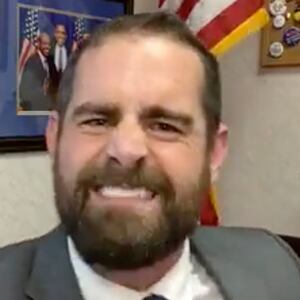Since the beginning of this year, Florida has experienced an uptick in the number of pneumonia and influenza deaths, according to data from the Centers for Disease and Control. Experts and Trump administration officials responsible for keeping tabs on mortality rates across the country believe that many of those individuals had likely contracted and died from COVID-19.
According to the data from the CDC’s National Center for Health Statistics, since the beginning of the year there has been a total of 1,519 deaths in Florida where pneumonia and influenza were listed as the underlying cause. By comparison, in the same time period last year, Florida recorded 1,207 such deaths. The CDC has historically counted pneumonia and influenza deaths together. CDC officials told The Daily Beast that most of the deaths included in that category are pneumonia.
Bob Anderson, the chief of the Mortality Statistics Branch in CDC’s National Center for Health Statistics, told The Daily Beast that the increase of deaths in Florida where pneumonia and influenza were the underlying cause was “statistically significant” and that those mortalities were “probably COVID cases that weren’t reported as such.” The coronavirus can cause lung complications such as pneumonia.
ADVERTISEMENT
The increase has sparked a conspiracy theory on the left, that Florida is deliberately trying to undercount coronavirus fatalities by labeling them as something else. There’s no evidence to suggest any such underhand efforts, or that the state is unique across the country. But officials, including Anderson, do believe that a portion of the pneumonia and influenza deaths in Florida involved patients who were infected with, but never tested for, COVID-19. In such scenarios, though the virus likely contributed to the death, it may not have been recorded as the cause of death by the physician, coroner or medical examiner.
“We’re definitely experiencing an underreporting issue nationwide,” Anderson said, pointing to the CDC’s study of “excess deaths” during the coronavirus. “[In Florida] most likely what we’re seeing are folks dying without having been tested and the best evidence that the doctors or whoever is filling out the death certificate had pointed to the person dying of pneumonia.”
Anderson added that the numbers currently reflected on the CDC’s website for pneumonia and influenza deaths for 2020 are lower than reality because the death certificate reporting system lags by several weeks, especially in states that do not have digitized systems to process the papers.
Though other states are experiencing a similar phenomenon, there has been notable scrutiny placed on Florida, due to Gov. Ron DeSantis’ (R) handling of the coronavirus response and his decision to move to quickly reopen the state. DeSantis allowed some Florida beaches to reopen in the middle of April, even as the number of coronavirus cases and related deaths continued to rise across the state. The governor has since criticized members of the press for rushing to warn that Florida would experience a spike in COVID-19 cases, and calling his actions cavalier. Conservative and Trump supportive commentators have pointed to the absence of a notable uptick as evidence that fears of a hasty reopening were overblown.
DeSantis’ office did not return a request for comment. But the actual story, like much related to the pandemic, appears to be more complicated. And it underscores how much of the public’s understanding of, and opinions about, the pandemic are affected by bureaucratic decisions and accounting formulas related to categorizing fatalities.
As The Daily Beast previously reported, President Trump and members of his coronavirus task force have pressed the CDC to change how the agency works with states to count coronavirus-related deaths, arguing for revisions that could lead to far fewer deaths being attributed to the disease. The administration has also moved to allow nursing homes the ability to only report coronavirus deaths that occurred after May 6—well after facilities across the country experienced a massive uptick in coronavirus-related deaths.
States, as well, have different methods of collecting relevant data and calculating COVID-19 death counts and that, in turn, has sowed speculation about political motivations. On that front, few governors have been as closely watched as DeSantis. Part of that is because of his close relationship with the president. Part of that is because of decisions he has made. Earlier this month the DeSantis administration fired Rebekah Jones, the data manager for the Florida Department of Health who worked on the state’s coronavirus online dashboard. In a statement posted to her website, Jones said she was removed from her position because she pushed back when officials in the health department asked her to “manipulate and delete data in late April as work for the state’s reopening plan started to take off.” The DeSantis administration has since said Jones was fired for insubordination.
With Florida already under a national microscope, news of the state’s pneumonia fatalities circulated on social media this week as liberals accused DeSantis and members of his administration of manipulating data and deliberately downplaying the number of coronavirus deaths. Howard Dean, the former Democrat governor from Vermont, commented on Florida’s statistics Thursday, going so far as to accuse Florida of “cooking the books on COVID-19 deaths.” Andy Slavitt, the former Acting Administrator of the Centers for Medicare and Medicaid Services, said while Florida appears to have the coronavirus under control, it was experiencing an “unprecedented ‘pneumonia’ crisis.”
But Anderson said it is unlikely that a physician with a patient who tested positive for the coronavirus would have marked anything other than COVID-19 as the underlying cause on the death certificate. If individuals die, for example, in their homes or in nursing facilities without having been tested, a medical examiner or coroner could hypothetically mark the individual as having died of pneumonia. That scenario would have likely played out in the early days of the coronavirus outbreak when testing was difficult to access and when physicians were still learning how the coronavirus presented itself, Anderson said. According to a report by the Miami Herald, officials inside the DeSantis administration kept the Florida public in the dark in February for about two weeks as they scrambled to come up with a plan on how to respond to the state’s outbreak.
A similar phenomenon took place in Flint after a switch in water supply exposed thousands of people to lead poisoning and caused one of the largest outbreaks of Legionnaires’ disease in U.S. history. Last year, a team of reporters at PBS Frontline found that there may have been about 70 more deaths from Legionnaires’ during the outbreak than the 12 that were officially recorded. But because the government was not forthcoming about the crisis, doctors were not alerted to it and therefore did not know to look or test for the disease. Many people who died of Legionnaires’ disease were originally reported as having died from other causes, such as pneumonia.
Currently, health officials and statisticians are researching how many of the states’ “excess deaths” over the last several months should be attributed to the coronavirus. One study by the New York City Department of Health and Mental Hygiene published earlier this month said that there were thousands of “excess deaths” in the city from March 11 to May 2. About 18,879 of those deaths were explicitly tied to the coronavirus. But the study said there were also an additional 5,200 deaths that were not identified as either laboratory-confirmed or probable COVID-19-associated cases, but could have been tied to the virus in some other way.
At the CDC, officials found 1,500 individuals who were mistakenly overlooked in the first few weeks the agency was calculating the coronavirus death count, and Anderson’s team is now going back and correcting those calculations to produce a more accurate death toll.
The CDC relies largely on the state department of health systems and a reporting system that is more than 100 years old to calculate the annual death toll in the U.S.. When an individual dies, a doctor, coroner or medical examiner records on the death certificate a sequence of events that contributed to that person’s demise and what ultimately caused it. The certificate then goes to the state’s registrar, or sometimes a funeral director, who examines the certificate and determines whether to send it back to the physician, coroner or medical examiner for more information. Once the state registrar is satisfied with the certificate, he or she sends it on to the state’s department of health. Then, the state sends portions of data from the death certificate onto the CDC.
Anderson’s team is charged with using that death certificate data, along with data from a national digital coding system, to tabulate causes of death per state each year.
The emergence of the coronavirus strained the reporting system in a way that has led to a significant national undercounting, Anderson said, adding that the death-certificate count usually lags anywhere from two to eight weeks.
“We’ve never experienced anything like this before,” Anderson said. “We’re still learning new things about this virus every day. The reporting will only get better.”








